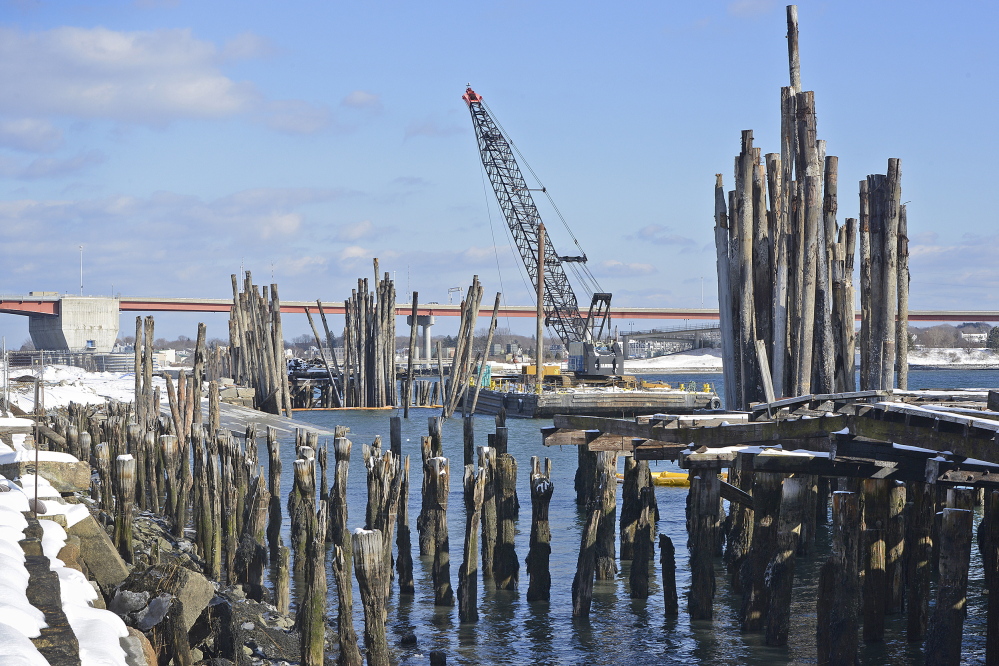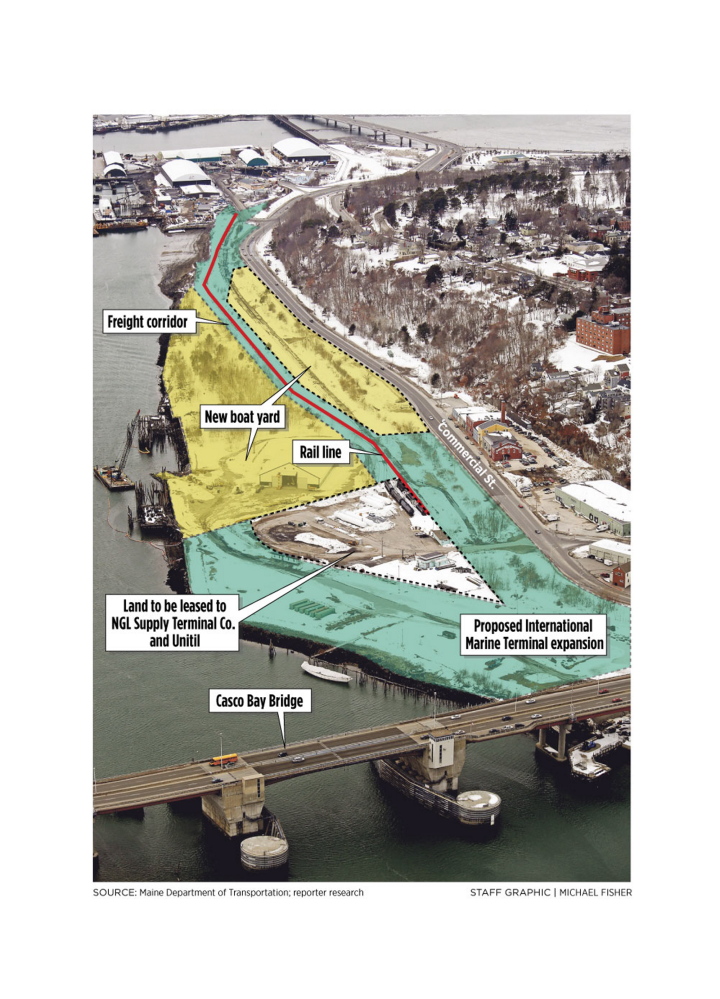State officials plan to expand the shipping-container terminal in Portland to more than double its current size and link it directly with a rail line, allowing the terminal to compete for business with other major ports along the East Coast.
The expanded International Marine Terminal would significantly lower costs for its commercial customers, make shipping faster and more efficient, and attract new international and domestic cargo business to Maine, officials said.
The expansion, whose cost has yet to be disclosed, would involve the taking of several acres of privately owned land by eminent domain because of a dispute over its value, the landowner and state officials said. State officials plan to put the project out for bids in June.
After decades of decline that left stretches of Portland’s industrial waterfront vacant and derelict, the port is on the upswing, said John Henshaw, executive director of the Maine Port Authority.
“This terminal expansion project represents the first time in 50 years that the port of Portland can fully realize its potential as a cargo port,” said Henshaw, whose office manages the city-owned container terminal at the foot of the Casco Bay Bridge.
The project would allow longshoremen, for the first time, to unload containers from ships and put them on trains in the same terminal, which would dramatically increase speed and efficiency.
With the project’s completion later this year, the state would end up owning a new rail line between Cassidy Point Drive, near Merrill’s Marine Terminal, and the line’s current terminus at a rail and truck propane terminal.
Rather than extend the rail line so it reaches the shipping-container terminal, the project would expand the terminal so it meets with the rail line, Henshaw said.
The 14-acre container terminal would be expanded to include about 12 acres on the west side of the Casco Bay Bridge, plus a five-acre strip that would serve as a rail corridor. The state also would buy four acres from Unitil and lease it back to the gas company, which now subleases two acres to NGL Supply Terminal Co. to operate the propane terminal.
Plans call for an internal road that would allow vehicles to haul containers from ships and load them onto trains parked between West Commercial Street and the NGL terminal.
The area to the west of the Casco Bay Bridge would become a “wheeled yard,” a place for trucks to drop off and pick up containers. Rail access and space for a wheeled yard is the highest priority, although a cold-storage warehouse could be an option in the future on other parts of the site, state officials said.
A CHANCE TO REACH NEW MARKETS
Henshaw said the project is needed to accommodate a proposed domestic cargo service and growth in the port’s international shipping business.
He said the Icelandic steamship line Eimskip, which began operations in Portland a year ago, would take advantage of the improved efficiency to cut rates for shippers. That would help Maine businesses improve service for current customers and expand into new markets that have been out of reach because of high transportation costs.
Eimskip connects Portland with ports in Northern Europe, Iceland and Newfoundland.
The port authority also is working with McAllister Towing and Transportation on a proposal for cargo service on a “marine highway” connecting Portland, New York and New Jersey. That plan is to use a tug-barge hybrid that, unlike a conventional barge, could carry containers in the open ocean in stormy winter weather.
State officials would not provide the cost of the project, which would be funded with a portion of the $24 million set aside for “multi-modal projects” in the transportation bond that Maine voters approved in November. Multi-modal projects involve more than one means of transportation, such as ships, trucks and trains.
Last week, Gov. Paul LePage ordered the state treasurer to stop issuing voter-approved bonds, in response to the Legislature’s plan to use money from the state’s rainy day fund to restore aid to Maine’s cities and town.
But Department of Transportation spokesman Ted Talbot said transportation officials don’t believe that order will stand in the way of the project’s funding.
“We don’t anticipate any issues,” Talbot said. “We have a high degree of confidence that these issues will be resolved.”
A LOT OF LAND CHANGING HANDS
The expansion project is requiring negotiations among multiple parties, including Pan Am Railways, Unitil, NGL and Phineas Sprague Jr., a Portland businessman who has been planning to build a boat yard on about 22 acres he owns next to the Casco Bay Bridge.
Sprague bought land from Pan Am Railways and Unitil in early 2012, before Eimskip decided to make Portland its only port of call in the U.S. and its North American headquarters.
The railroad and the state have agreed on a sale price for the railroad’s land and are putting the final touches on their agreement, said Cynthia Scarano, executive vice president of Pan Am Railways.
However, Sprague and state officials said they remain far apart on the value of Sprague’s land.
According to the Portland Assessor’s Office, Sprague paid about $875,000 for the 15 acres he bought from Pan Am in 2012. No sale price is listed for the seven acres he bought from Unitil, and Sprague would not disclose the price.
State officials said they plan to use the power of eminent domain next month to take most of Sprague’s property, which would enable them to move forward on the expansion this year.
Sprague said the process is not confrontational because he understands the project’s importance to the port’s economic viability. He said the eminent domain process allows the state to begin work while providing him with a legal process that lets him contest the state’s appraisal of the land.
“They reality is that they are the sovereign. They get to do anything they want,” Sprague said. “The issue is, what is the fair market value?”
The U.S. and Maine constitutions allow government agencies to take land and compensate owners if the land is to be used for public purposes, such as highways or rail lines.
Sprague plans to use his profit from the sale to buy the rest of the railroad’s land, west of the gas terminal. That would give Sprague access to his boat yard from West Commercial Street. He also plans to build offices and a marine retail store along the street.
Pan Am Railways would no longer own any land east of Cassidy Point Drive, said Scarano, the railroad executive.
MEETING TO GATHER PUBLIC INPUT
Larus Isfeld, managing director of Eimskip USA, said the expansion is critical to the company’s ability to expand its business in Portland.
“We look at rail access in every port as a strategic necessity for long-term growth,” he said. “ Intermodal rail has been growing in the United States over the last 10 years and will continue to grow. Maine has to follow suit with the rest of the country to stay competitive.”
The project would not require a zoning change, but will go to Portland’s Planning Board for site plan review.
Before it submits the plan to the city, the Department of Transportation is looking for feedback from the public. It will hold a meeting on the project at 6 p.m. on March 12 in the State of Maine Room at Portland City Hall.
State officials got a warm welcome Tuesday from residents of the adjacent neighborhood when they presented their expansion plan at the Reiche Community School.
Anne Pringle, a resident of the West End who is a longtime advocate of protecting Portland’s working waterfront from being developed for non-marine uses such as condos, said it is gratifying to finally see the port’s revival.
“This is the Portland working waterfront we had always hoped for in the West End,” Pringle said.
Tom Bell can be contacted at 791-6369 or at:
tbell@pressherald.com
Send questions/comments to the editors.




Success. Please wait for the page to reload. If the page does not reload within 5 seconds, please refresh the page.
Enter your email and password to access comments.
Hi, to comment on stories you must . This profile is in addition to your subscription and website login.
Already have a commenting profile? .
Invalid username/password.
Please check your email to confirm and complete your registration.
Only subscribers are eligible to post comments. Please subscribe or login first for digital access. Here’s why.
Use the form below to reset your password. When you've submitted your account email, we will send an email with a reset code.